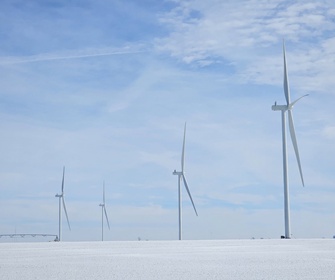To explore opportunities for widespread deployment of distributed wind in 2035, NREL completed the Distributed Wind Energy Futures Study. The Distributed Wind Energy Futures Study builds on NREL's 2016 first-ever exploratory analysis of future opportunities for behind-the-meter distributed wind systems.
Consistent with the 2016 study, NREL finds U.S. distributed wind has abundant economic potential, or the potential that would have a positive return on investment. Entire regions of the country could profitably provide hundreds of gigawatts today if deployed. In 2035, terawatts of capacity could be possible.
NREL examined three primary factors that could help unlock distributed wind's potential:
- Improved financing and performance to reduce the cost of wind energy
- Relaxed siting restrictions to open up more available land for wind development—a previous NREL study revealed a 7X difference in total U.S. wind technical potential in 2050 between the least and most restrictive siting restrictions
- An investment tax credit renewal and net metering. Currently, customers can receive a 26% tax credit for qualifying wind turbines below 100 kilowatts and solar panels installed between 2020 and 2022. The tax credit will expire in 2024 unless Congress renews it. Net metering is a metering and billing arrangement where distributed energy generation system owners are compensated for any generation that is not used and exported to the utility grid.
Under the most optimistic conditions—including aggressive cost declines, more relaxed siting constraints than today, and strategic extension and expansion of current tax credits and policies—NREL finds front-of-the-meter wind could provide over 4,000 gigawatts of capacity and behind-the-meter wind could provide over 1,700 gigawatts of capacity in 2035. In the least optimistic conditions, front-of-the-meter wind capacity decreases to 42 gigawatts and behind-the-meter wind capacity to 440 gigawatts in 2035.
The Midwest and Heartland regions overall have the highest potential for distributed wind, and the Pacific and Northeast regions have significant potential for expansion of behind-the-meter distributed wind deployments.
As modeled, agricultural land has the highest distributed wind potential, but residential, commercial, and industrial land also have gigawatt-scale potential, particularly for behind-the-meter applications.
NREL finds states with the most near-term potential for behind-the-meter applications include Texas, Minnesota, Montana, Colorado, Oklahoma, and Indiana. States with the most near-term potential for front-of-the-meter applications include Oklahoma, Nebraska, Illinois, Kansas, Iowa, and South Dakota.
States across much of the Northeast as well as California have lower quantities of profitable distributed wind potential, but there are select locations with significant wind resources, which when combined with generally higher retail electricity rates in these regions means there are compelling opportunities in there too.








